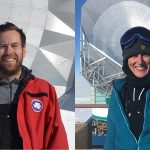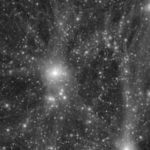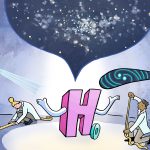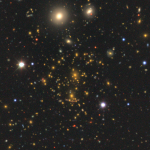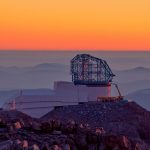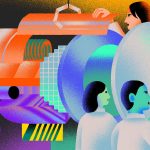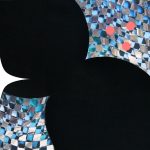The Event Horizon Telescope collaboration, which announced the first image of a supermassive black hole in April, has won the 2020 Breakthrough Prize in Fundamental Physics. Fermilab scientists Bradford Benson and Alexandra Rahlin are among a large group of scientists who share the prize for their contributions to the achievement.
astrophysics
Few numbers have gotten under astronomers’ skin like the Hubble constant. In fact, experts have debated the value of this single parameter for 90 years, and if astronomers can measure its value with great precision, they’ll be one step closer to solving some of the other grand astronomical mysteries of our age. There’s just one problem: The measurements they’ve taken don’t agree. The discrepancy makes scientists question whether something is amiss in our understanding of the universe.
It took three sky surveys to prepare for a new project that will create the largest 3-D map of the universe’s galaxies and glean new insights about the universe’s accelerating expansion. This Dark Energy Spectroscopic Instrument project will explore this expansion, driven by a mysterious property known as dark energy, in great detail. The surveys, which wrapped up in March, have amassed images of more than 1 billion galaxies and are essential in selecting celestial objects to target with DESI, now under construction in Arizona.
Scientists at SLAC National Accelerator Laboratory are building the world’s largest digital camera for astronomy and astrophysics — a minivan-sized 3200-megapixel “eye” of the future Large Synoptic Survey Telescope that will see light in 2022. In the meantime, the lab has completed its work on a miniature version that will soon be used for testing the telescope and taking LSST’s first images of the night sky. ComCam will help test the observatory once it is installed in Chile later this year.
In a brightly lit clean room at SLAC National Accelerator Laboratory, engineers are building a car-sized digital camera for the Large Synoptic Survey Telescope. When it’s ready, LSST will image almost all of the sky visible from its vantage point on a Chilean mountain, Cerro Pachón, every few nights for a decade to make an astronomical movie of unprecedented proportions. Building the LSST means solving extraordinary technological challenges.
From Cosmos, May 6, 2019: An extensive analysis of four different phenomena within the universe points the way to understanding the nature of dark energy, the Dark Energy Survey reveals.
Scientists think that, under some circumstances, dark matter could generate powerful enough gravitational waves for equipment like LIGO to detect. Now that observatories have begun to record gravitational waves on a regular basis, scientists are discussing how dark matter—only known so far to interact with other matter only through gravity—might create these gravitational waves.
From ABC7: Fermilab scientist Brad Benson talks about the South Pole Telescope’s role part in the Event Horizon Telescope. Scientists behind the Event Horizon Telescope recently revealed the first image ever made of a black hole, depicting its hot, shadowy edges where light bends around itself in a cosmic funhouse effect. Assembling data gathered by eight radio telescopes around the world, astronomers created the picture showing the violent neighborhood around a supermassive black hole, the light-sucking monsters of the universe theorized by Einstein more than a century ago and confirmed by observations for decades.
From WBEZ’s Morning Shift, April 10, 2019: WBEZ interviews Fermilab scientist Brad Benson about the recent unveiling of the first ever photograph of a black hole. The Event Horizon Telescope, a collaboration between more than 200 scientists using telescopes from around the world, shot photographs of a supermassive black hole in the galaxy M87.

